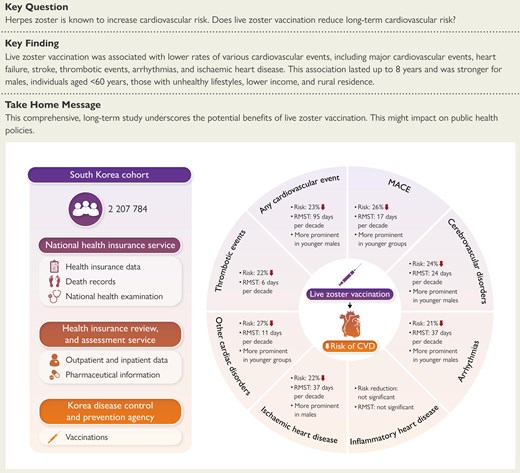-
Views
-
Cite
Cite
Sooji Lee, Kyeongmin Lee, Jiyeon Oh, Hyeon Jin Kim, Yejun Son, Soeun Kim, Jaeyu Park, Jiseung Kang, Damiano Pizzol, Jinseok Lee, Ho Geol Woo, Hayeon Lee, Dong Keon Yon, Live zoster vaccination and cardiovascular outcomes: a nationwide, South Korean study, European Heart Journal, 2025;, ehaf230, https://doi.org/10.1093/eurheartj/ehaf230
Close - Share Icon Share
Abstract
Despite the potential association between herpes zoster infection and cardiovascular events, limited studies have investigated the relationship between live zoster vaccination and cardiovascular outcomes. This large-scale, population-based cohort study with a long-term follow-up aimed to investigate the association between live zoster vaccination and the risk of various cardiovascular events.
Data on comprehensive information of individuals aged ≥50 years from South Korea (n = 2 207 784) were included from 1 January 2012, to 31 December 2021. National insurance information from the Korea Health Insurance Review and Assessment Service, the national health examination results from the Korean National Health Insurance Service, and the live zoster vaccination data from the Korea Disease Control and Prevention Agency were merged. The risk of incident cardiovascular outcomes after live zoster vaccination was assessed compared with unvaccinated individuals. The primary outcome was the risk of cardiovascular diseases based on International Classification of Diseases, Tenth Revision code diagnosis. In propensity score–based overlap weighted cohorts, Cox proportional hazard models were used to estimate hazard ratios (HRs) for overall and specific cardiovascular outcomes, while calculating restricted mean survival time (RMST) for each outcome. The observation period was from 1 January 2012, to 31 January 2024. Multiple stratification analyses were performed.
After applying propensity score–based overlap weighting, 1 271 922 individuals were included [mean age, 61.3 years (standard deviation, 3.4); 548 986 (43.2%) male; median follow-up time, 6.0 years] in overlap-weighted cohort. Live zoster vaccination was associated with lower risks of overall cardiovascular events [HR 0.77, 95% confidence interval (CI) 0.76–0.78], particularly major adverse cardiovascular events [0.74 (0.71–0.77)], heart failure [0.74 (0.70–0.77)], cerebrovascular disorders [0.76 (0.74–0.78)], ischaemic heart disease [0.78 (0.76–0.80)], thrombotic disorders [0.78 (0.74–0.83)], and dysrhythmia [0.79 (0.77–0.81)]. The RMST difference for overall cardiovascular events following live zoster vaccination was 95.14 days per decade (95% CI 94.99–95.30). The protective association persisted up to 8 years, with the greatest reduction observed 2–3 years post-vaccination. The decrease in cardiovascular disease risk was more pronounced among males, individuals aged <60 years, those with unhealthy lifestyle habits, and those from low-income households and rural residents.
These findings suggest that live zoster vaccination may be beneficial as a public health strategy with potential implications for cardiovascular disease burden in the general population. This strategy may help address health disparities and mortality linked to cardiovascular complications.





